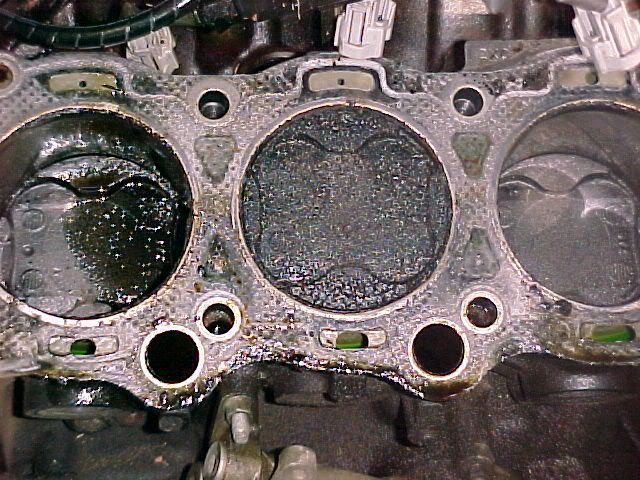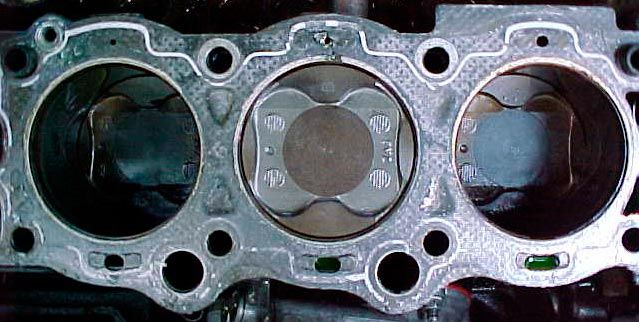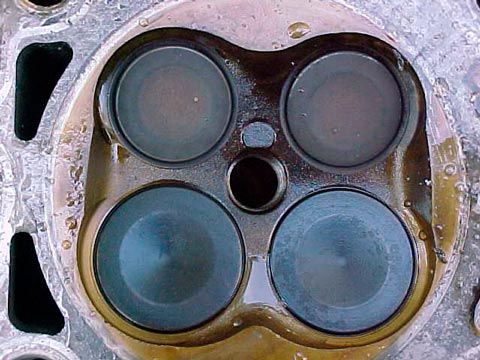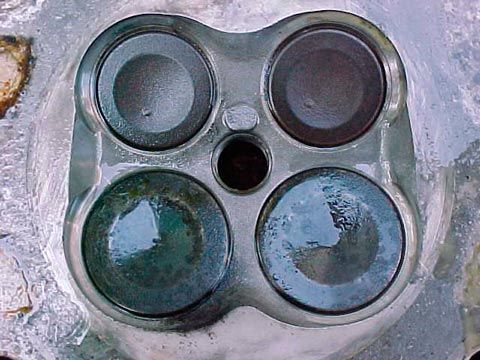One more question, and I will let this die. So, from my understanding, then, filtered, or distilled water, with less/no contaminants, would be okay, or maybe some fuel power or LC mixed in, hmm, got me thinking. Can't access much here, aside from the FP and LC I got from Singapore, and probably some really cheap FI cleaner. Wondering if mixing some conconction would be better than running straight water.quote:
Originally posted by Terry:
Shaman, Contaminants and minerals in water will abrade and corrode metals, the lubricants added to Seafoam would inhibit the corrosive effect, they would have no effect on the abrasion wear.
You are using an out of date browser. It may not display this or other websites correctly.
You should upgrade or use an alternative browser.
You should upgrade or use an alternative browser.
Seafoam, my long time experiance with it & directions
- Thread starter Toysrme
- Start date
- Status
- Not open for further replies.
Terry, it's too bad that more forum members don't just use Auto-RX as is. It must be too simple. I think some of these products that require one to pour stuff in the intake stream somwwhere require a little practice to get it right. Auto-RX is simple. And you're right, slow is better, sometimes.
By the way, how'd you like talking to truck drivers with Jeff?
By the way, how'd you like talking to truck drivers with Jeff?
Shaman, use FP just like you would use Seafoam as a intake vaccum pulled solvent and let me know what you think.
LarryL, I was busy running to each major oil manufactorers display and pinning them down to consider LC as a low cost AO add !
I did speak with Ron of Magna-guard/FluidRx about a Power steering fluid project. Should have gone to the Xentx booth for some deeper insight into the product.
Terry
LarryL, I was busy running to each major oil manufactorers display and pinning them down to consider LC as a low cost AO add !
I did speak with Ron of Magna-guard/FluidRx about a Power steering fluid project. Should have gone to the Xentx booth for some deeper insight into the product.
Terry
I wish people would explain how they determined something "worked" or did not work. The "butt dyno" , "runs smoother", "quieter", etc are all worthless indicators IMHO.
Take for instance engine flushes. There are various ways to detemine if they work, but most indicators would be difficult to measure without engine dissassembly. Some good indicators are; increase in cylinder compression, removal of sludge upon valve cover removal, reduction in oil consumption, reduction in leakage from seals, dramatic increase of mpg (ie greater than 5-10%), resumption in normal oil pressure (for severe cases). Often we see comments like; "it runs smoother", "more high end power".
Take for instance engine flushes. There are various ways to detemine if they work, but most indicators would be difficult to measure without engine dissassembly. Some good indicators are; increase in cylinder compression, removal of sludge upon valve cover removal, reduction in oil consumption, reduction in leakage from seals, dramatic increase of mpg (ie greater than 5-10%), resumption in normal oil pressure (for severe cases). Often we see comments like; "it runs smoother", "more high end power".
- Joined
- Sep 28, 2002
- Messages
- 39,799
I find this very hard to imagine. Either the hose had to be very large ...and/or very short. "Induced" (drawn) liquid flow into the engine is somewhat self regulating. I've had 1 gallon containers of water/fluids that I've induced from inside the passenger compartment (and under the hood) and have run the engine from idle to WOT ..and cycling. If the fluid stiffles the combustion process ..the vacuum is knocked down ..less induction.quote:
The guy accidentally dropped his vacuum line into a full can while a friend held the engine to a cruising speed.)
OTOH - if you're pouring it in and the engine stalls

I really have a very hard time imaging this ever happening as you describe.
Are you asking metaphorically or are you asking because you donn't know if it has been done yet?quote:
Originally posted by Terry:
Shaman, use FP just like you would use Seafoam as a intake vaccum pulled solvent and let me know what you think.
I will be trying it sometime in the next month. Just trying to find out it if would be better to mix with something or run it straight.
The thing I liked about water was I could suck it up for as long as I wanted and not have to worry about cost. Used a 1.5 liter bottle last time I did a water suck. I will try a few oz of FP and see if I like what is happening. IF not, anot oz will be mixed with some water and I will go to town.
Let me rephrase, been in Japan too long. Have you used it before, or were you aksing me to be a guinea pig?quote:
Originally posted by Terry:
Shaman, use the FP as I indicated. I have used FP and it works well. Cheaper than anything else that and won't corrode,or abrade anything. Don't hydrolock.
I don't use metaphors to clean engines !
Okay, Ive gotta ask now...Ive read reference in everyone of these vaccume cleaning method topics to "hydrolock", appearantly it happens next to no-one yet everyone cautions it...and Ive yet to understand exactly is meant? I mean what really happens? And why?
Water in the combustion chamber. Liquid can't be compressed, so you have the piston trying to compress something that can't be. Something, a rod, the piston, valve, will break.
Take a hyperdermic and put in some water and seal off the end. Then try to push the plunger down.
Take a hyperdermic and put in some water and seal off the end. Then try to push the plunger down.
I have a vacuum hose pump coming from America. When it gets here it will get hooked up to a vacuum port. We got it at Walmart for$2.99 or something. The end that attaches to the rubber ball(pump), is a screw-in plastic adapter that reduces the hose down to smaller than BB size. I figure with rpms at 2000 rpms or so there shouldn’t be a problem.
Hydrolock is when there is too much fluid in the combustion chamber that can’t be combusted or compressed. For example, if you were driving through REALLLLLYYYY deep water rich, you could possibly hydrolock your engine. You intake opening would have to be completely submerged in water for this to happen. Another way, and what is being warned about here, is through vacuum hoses. Water poses more of a risk than FI cleaner or anything that burns because it doesn’t. If too much water gets into a cylinder, it won’t combust, and will bend the rod, or crack the piston, or drop the valve, whatever combustion motion you prefer.
So basically to prevent, you keep the vacuum up, don’t stick the hose all the way in, although I have done it several time, keep the throttle up so you don’t stall it until you are done. Try to find a hose located in the front of your intake tract. The closer you get to the combustion chambers, the less likely you are to get central spread of the fluid. Many people will suck it through many holes. Even saw an LT1 write up of an order to suck it up.
Hydrolock is when there is too much fluid in the combustion chamber that can’t be combusted or compressed. For example, if you were driving through REALLLLLYYYY deep water rich, you could possibly hydrolock your engine. You intake opening would have to be completely submerged in water for this to happen. Another way, and what is being warned about here, is through vacuum hoses. Water poses more of a risk than FI cleaner or anything that burns because it doesn’t. If too much water gets into a cylinder, it won’t combust, and will bend the rod, or crack the piston, or drop the valve, whatever combustion motion you prefer.
So basically to prevent, you keep the vacuum up, don’t stick the hose all the way in, although I have done it several time, keep the throttle up so you don’t stall it until you are done. Try to find a hose located in the front of your intake tract. The closer you get to the combustion chambers, the less likely you are to get central spread of the fluid. Many people will suck it through many holes. Even saw an LT1 write up of an order to suck it up.
Gary Allan hydrolocking can happen very easily. Most engine's produce some 30-40in/hg of vacuum from the manifold (post throttle plate) when idling. Fluid is sucked into the engine at a very high rate.
ShortBuSX Exactly what they told you.
Fluids (in normal physics) are incompressable. A hydrolock is when there is enough fluid in the combustion chambers to stop the pistons from compressing.
When that happens, the most common damage (if anything is damaged) are spun rod bearings, snapped rods, associated connecting hardware. It doesn't even take the engine to stop. A sudden harsh decceleration can be enough to break weak/old parts.
It comes down to the squish area in the combustion chambers as to how much fluid it takes to hydrolock an engine.
You avoid hydrolocking all-together by using the recommended amounts I originally posted. Simply put, it's infeasable it will happen unless you have some very high compression engine.
ShortBuSX Exactly what they told you.
Fluids (in normal physics) are incompressable. A hydrolock is when there is enough fluid in the combustion chambers to stop the pistons from compressing.
When that happens, the most common damage (if anything is damaged) are spun rod bearings, snapped rods, associated connecting hardware. It doesn't even take the engine to stop. A sudden harsh decceleration can be enough to break weak/old parts.
It comes down to the squish area in the combustion chambers as to how much fluid it takes to hydrolock an engine.
You avoid hydrolocking all-together by using the recommended amounts I originally posted. Simply put, it's infeasable it will happen unless you have some very high compression engine.
I just finished a set of copper headgaskets to stand up for twin turbos. Just tore the heads off.
2 cans of Seafoam put throuhg the intake (as I said above in 1/3 can intervals) has cleaned the carbon off the pistons.
Look at what water injection does for the combustion area, valves & the valve cutouts on the piston.


Like I said, water injection doesn't just kick everything else's arse in the combustion chamber, it does it hardcore!
WI2WIN.
2 cans of Seafoam put throuhg the intake (as I said above in 1/3 can intervals) has cleaned the carbon off the pistons.
Look at what water injection does for the combustion area, valves & the valve cutouts on the piston.


Like I said, water injection doesn't just kick everything else's arse in the combustion chamber, it does it hardcore!
WI2WIN.
OK that host is horrible. (btw time limit on editing posts is no cool...)
(For people not use to looking at a torn apart engine, disregard any fluid. They leak in when you break seals tearing them down)
This time last year:

Check what seafoam did

Many times cleaner! 0 Carbon! Bearly good & gold!.
Seafoam VS water injection:
sf

wi

Beautiful... No debating how good WI is.
(For people not use to looking at a torn apart engine, disregard any fluid. They leak in when you break seals tearing them down)
This time last year:

Check what seafoam did

Many times cleaner! 0 Carbon! Bearly good & gold!.
Seafoam VS water injection:
sf

wi

Beautiful... No debating how good WI is.
Thanks for the pics Toys. These are like BITOG pron. Anyway, can you give us a few more details? You tore apart your engine. Did not clean the carbon off the pistons. Reassembled. Used Seafoam on half the engine. Water injection on the other half. And then took pictures? Great experiment! But is that what you really did?
You've almost got it.
The carbon filled pic was from last winter when I rebuilt the enigne.
Correct - I left the pistons ditry to see what would happen.
The engine was Seafoamed several time in March/April to clean carbon out in preperation for force induction. The engine ran a month before I took it back apart - so I'm sure there is a tiny bit more coloration around the exhaust valves & on the pistons than would have been if it was fresh.
(I'm human, deal with it LoL!)
The engine has been hipo N/A, turboed, hipo N/A, turboed, and back to hipo N/A since April/May. Anytime it was turboed, I was running a lot of on boost water injection.
I took pics just to compair & contrast.
The water injection pic of the chamber was from right after the last time I was running water injection, before they could "dirty back up".
For the astute, that particular chamber was having a light ping (the things we do in the quest for go-fast!) in the second half of August before I took the turbo back off. See the black stain comming from the intake valve? That's where the pre-ignition was from. =)
The carbon filled pic was from last winter when I rebuilt the enigne.
Correct - I left the pistons ditry to see what would happen.
The engine was Seafoamed several time in March/April to clean carbon out in preperation for force induction. The engine ran a month before I took it back apart - so I'm sure there is a tiny bit more coloration around the exhaust valves & on the pistons than would have been if it was fresh.
(I'm human, deal with it LoL!)
The engine has been hipo N/A, turboed, hipo N/A, turboed, and back to hipo N/A since April/May. Anytime it was turboed, I was running a lot of on boost water injection.
I took pics just to compair & contrast.
The water injection pic of the chamber was from right after the last time I was running water injection, before they could "dirty back up".
For the astute, that particular chamber was having a light ping (the things we do in the quest for go-fast!) in the second half of August before I took the turbo back off. See the black stain comming from the intake valve? That's where the pre-ignition was from. =)
How are you doing water injection? I use a
basketball inflation needle stuffed into a hose and and do it on the highway at speed using distilled water. Is there a better way?
So the Seafoam goes all in at once? At idle? I fail to see how it can be effective if it's mostly oil and not much solvent. What am I missing?
basketball inflation needle stuffed into a hose and and do it on the highway at speed using distilled water. Is there a better way?
So the Seafoam goes all in at once? At idle? I fail to see how it can be effective if it's mostly oil and not much solvent. What am I missing?
40 in/Hg vacuum? What planet are you on? Obviously not the Earth.quote:
Originally posted by Toysrme:
Gary Allan hydrolocking can happen very easily. Most engine's produce some 30-40in/hg of vacuum from the manifold (post throttle plate) when idling. Fluid is sucked into the engine at a very high rate.
You could run an Earthling garden hose full blast into a medium sized engine turning 1000 rpm and not come close to hydrolock. It would cause the engine to stop because it would put the fire out, then you could get enough water into the chambers to hydrolock it next time you tried to start it.
- Status
- Not open for further replies.
Similar threads
- Replies
- 30
- Views
- 12K
